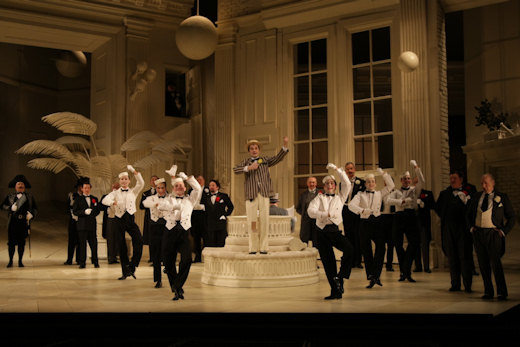Other Links
Editorial Board
- UK Editors
- Roger Jones and John Quinn
Editors for The Americas - Bruce Hodges and Jonathan Spencer Jones
European Editors - Bettina Mara and Jens F Laurson
Consulting Editor - Bill Kenny
Assistant Webmaster -Stan Metzger
Founder - Len Mullenger
Google Site Search
SEEN AND HEARD UK OPERA REVIEW
Sir Arthur Sullivan, The Mikado: Soloists, Chorus and Orchestra (Peter Robinson - conductor) of English National Opera at the London Coliseum, 26.2.2011 (KC)
Cast:
Ko-Ko Richard Suart
Nanki-Poo Alfie Boe
Yum-Yum Sophie Bevan
Pooh-Bah Donald Maxwell
Katisha Anne Marie Owens
The Mikado of Japan Richard Angus
Pish-Tush William Allenby
Peep-Bo Fiona Canfield
Pitti-Sing Claudia Huckle
Director Jonathan Miller
Associate Director Elaine Tyler-Hall
Set Designer Stefanos Lazaridis
Costume Designer Sue Blane
Lighting Designer Davy Cunningham
Choreographer Anthony van Laast
Revival Choreographer Stephen Speed
Dialogue Coach Selina Cadell
Original Text Sir Willam Schwenck Gilbert

Alfie Boe and the Men's Chorus - Picture
© XMO4.com
‘The Mikado’ had its first outing at the Savoy Theatre in 1885. Gilbert was very particular that the costumes’ design should be meticulously accurate – insisting, right up to his death in 1911, 26 years later, that they should always be used.
These strange, gaudy costumes (and equally strange hair styles) must have given audiences a startling visual shock. On stage, moving about, speaking and singing in English were - in effect - alien creatures. The field was open for Gilbert to ascribe to these strange beings whatever beliefs, customs and ways of behaving he chose. In his own words, with tongue well in cheek, he wrote ‘at the date of my story, (Japanese people) had peculiar tastes, ideas and fashions of their own, many of which they discarded when they found that they did not coincide with the ideas of the more enlightened countries of Europe.’ (WSG 1886) Thus, neither plot nor context were ever intended to depict actual Japanese life and culture.
Gilbert’s ‘Japan’ more resembled a country suited to appear in ‘Gulliver’s Travels’ (e.g. Laputa). Like Swift, Gilbert used the notion of ‘foreign parts’ to scrutinise his own country satirically. G.K. Chesterton commented that ‘Gilbert persecuted the evils of modern England till they had literally not a leg to stand on’. His means were Topsy-turveydom, i.e. giving ‘his characters qualities exactly opposite to those they would possess in real life’ and setting them in a ‘cuckoo land’ in which ‘it is only the possible that never happens’. (See Gilbert the Artist in the programme notes).
Over its first hundred years, the work was hugely popular. The productions, however, remained broadly the same, due to stultifying copyright restrictions. ‘The Mikado’ became a much-loved old war-horse whose style and content became irretrievably dated as civilised life moved elsewhere.
Then Jonathan Miller’s version of ‘The Mikado’ arrived. This was in 1986 - one year after the centenary of the first production. To several intents and purposes, this was a ‘Miller’ creation.
In this 2011 revival, we are celebrating the 25th anniversary of Jonathan Miller’s version – and to a lesser extent the 126th anniversary of Gilbert & Sullivan’s original.
Miller’s version is spectacular. Its setting is a sparkling, white hotel, classical in grandeur, art nouveau in style, set by the English seaside – with something of the character of the Burgh Island Hotel in Devon. The keynote is nostalgia for moneyed idleness – the lives of beautiful people in the 1920s and 1930s. It’s a world most of us never knew, but which has nevertheless become familiar through such as Scott Fitzgerald, Evelyn Waugh, P. G. Wodehouse, Beverley Nichols and Agatha Christie. Wherever you look, you see hordes of immaculately dressed, impeccably disciplined, ceaselessly-busy menials. They move about their business silently and anonymously with quite as much stylistic precision and formality as, in their own way, Japanese samurai. Visually, their routines have breath-taking panache. The audience loved them – costumes and set.
Visitors to the hotel wear clothes that proclaim: ‘We’re English! Anyone for tennis?’. We encounter blazered schoolgirls from finishing school (Miss Yum-Yum etc.), a ruler’s son travelling incognito in an elegantly-tailored suit whose one large patch, above his right knee, declares his feigned obscurity and penury (Mr Nanki-Poo), a Rotary Club member who has accumulated offices of state through absence of any other contenders (Mr Pooh-Bah), a Lord High Executioner trained as a tailor whose simpering resembled Anton Walbrook contorted into a somewhat lachrymose parody of himself (Mr Ko-Ko) and, in the second act only, the large padded figure - a pale, imitation of the great Belgian Detective - looking forward to his lunch with keen anticipation, bumbling and amiable but bereft of fearsome ‘little grey cells’ (Mr Mikado) together with a woman born to be spinster headmistress of a ‘good’ girls’ school but determined to be married instead (M/S Katisha). As you see, a crowd of typical upper class Brits.
Messrs Suart, Angas and Maxwell were in fine fettle, veterans of the original production. Sophie Bevan and Alfie Boe were engaging newcomers. Anne Marie Owens looked the part , but did not quite attain a rich enough vocal authority. The orchestra sufficed but lacked the edge that long acquaintance with Sullivan’s music can bring.
I was thrilled and entranced by the regimented, stylised panache of the set, the costumes, the chorus and the principals. Its swagger took my breath away. It was inoffensive too. There was nothing to frighten the horses, nothing controversial.
This was innocuous entertainment, no more. Gilbert's original - lightly
- had had some content, too and was not afraid to indicate the existence of darker matters such as injustice and threat.
Ken Carter
